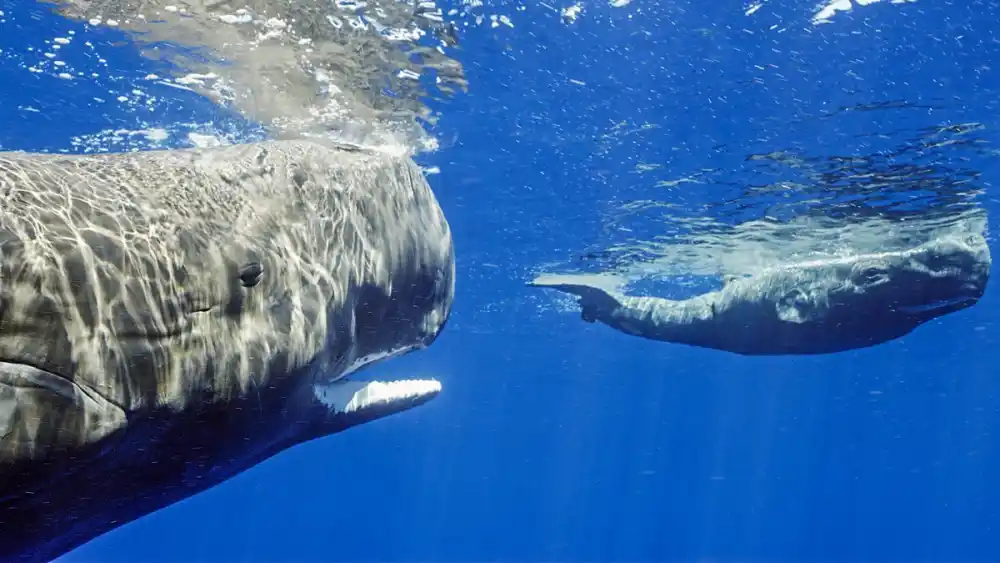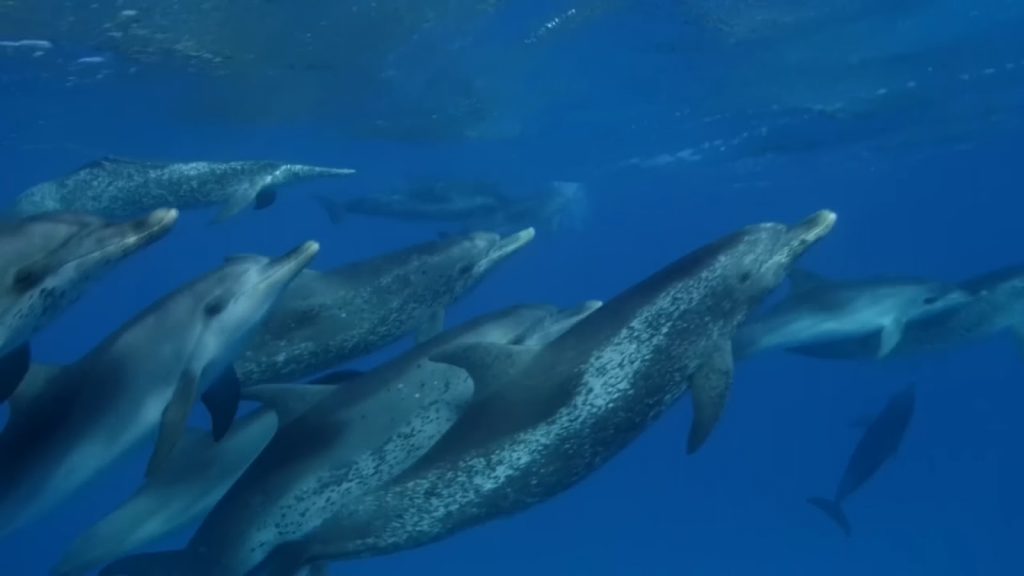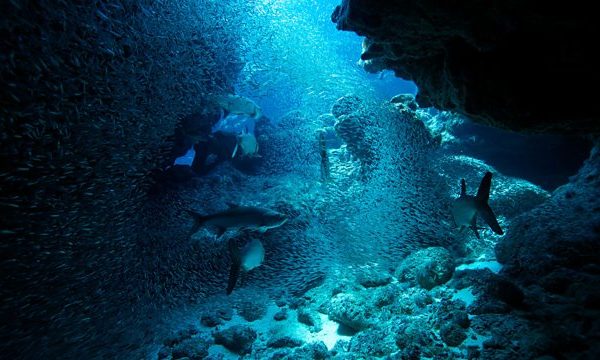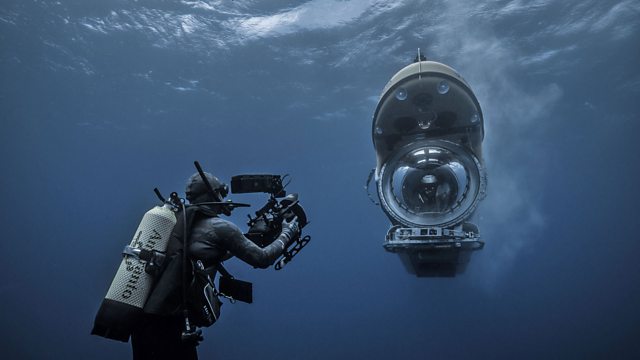Spy in the Ocean episode 1 – A new generation of spy creatures search the ocean for intelligent life and find ways of thinking that have to be seen to be believed. The most complex spy creature ever built films the owner of the largest brains on the planet – sperm whales. Spy Whale is the same size as a new-born whale calf and is equipped with an array of cameras. It even has a hydrophone to capture their calls. In a magical close encounter, Spy Whale is greeted by an inquisitive female who, in astonishing scenes, attempts to communicate. In a touching sign of acceptance, she even introduces her calf to Spy Whale.
Getting to know the greatest mind in the invertebrate world requires a very different spy, one that’s a dead ringer for the coconut octopus it’s designed to meet. The octopus not only has a central brain; it also has a brain in each of its arms. Using its combined brainpower, it works out how best to steal a coconut shell carried by our spy. Its plan is to use the shell as a door to its hideaway to protect itself from predatory sharks. In another act of ingenuity, it improvises a shield and throws missiles at a rival octopus. It also shows a softer and more emotional side when it gives Spy Coconut Octopus a friendly and lingering embrace.
In Thailand, Spy Macaque joins ocean-diving macaques as they forage underwater for seafood. Our spy captures a filming-first as the macaques catch fish with their bare hands. To break open oysters, they also use stone tools including our very own spy rock. In Japan, Spy Puffer becomes an artist’s assistant to a male Japanese puffer fish as he crafts exquisite sand sculptures in a quest to woo a mate. When he runs out of shells to use as decoration, Spy Puffer comes to the rescue, finding shells for the male to complete his masterpiece, enough to impress the most demanding art critic of all – his mate.
Intelligence gathers pace when Spy Sea Lion meets the world’s fastest fish and the sea lions that hunt them. Marlin use teamwork to drive mackerel shoals to the surface only for them to be stolen by quick-thinking sea lions. When Spy Sea Lion takes us on a rollercoaster ride inside the shoal, its camera eyes show how the shoal’s swarm intelligence is pitched against that of the clever sea lions. It also discovers some extraordinary new behaviour as the sea lion gift some of their catch to the marlin.
Spy in the Ocean episode 1
On a Caribbean beach, another spy meets the crab world’s most entertaining characters – hermit crabs. They may be comical in nature, but they also have highly developed organisational skills. When they’ve outgrown their shells, they line up in order of size to exchange them for a better fit. All is going well until Spy Hermit Crab loses its shell to a crab looking to upsize its accommodation. The crab becomes the unwitting camera operator as it captures a crab’s-eye view of the organised chaos.
On another Caribbean island, a colony of wild pigs embrace beach life by taking a daily dip in the sea. Spy Pig joins their daily ritual as they forage for food brought in by visiting boats. As their ingenuity draws the crowds, Spy Pig gets caught up in the resulting feeding frenzy. Back on the reefs, Spy Coconut Octopus donates its shell to a family of enterprising clownfish. In an astonishing show of teamwork, the fish work together to move the shell back to their anemone home, creating a safe place to lay their eggs among the poisonous tentacles.
In this action-packed first episode, our spies discover sea creatures with many mind-boggling ways of thinking, but none match those with the biggest brains of all – sperm whales. In more astonishing scenes, Spy Sperm Whale witnesses a rare and beautiful gathering as whale families from far and wide huddle together and exchange information – an extraordinary display of social intelligence, uncannily similar to our own.
Spy in the Ocean episode 1 – The Mysterious Deep: The Enigmatic Life of Sperm Whales
Unveiling the Titans of the Deep
Sperm whales are formidable creatures, the largest of the toothed whales, that dive into the ocean’s abyss with the ease of a bird taking flight. These gentle giants inhabit a world beneath the surface that’s as diverse and intricate as the terrestrial ecosystems we’re familiar with. Their lifestyle, shrouded in mystery and fascination, offers a glimpse into an existence far removed from our own, presenting a wealth of knowledge waiting to be unearthed.
These colossal creatures have long captivated our collective imagination. Famed for their starring role in Herman Melville’s novel “Moby Dick,” they’ve become symbols of the formidable power and enigmatic beauty of the natural world. Yet, despite their cultural significance, much of their lives remain hidden from human eyes. Their preference for deep waters and their elusive behavior make them difficult to study, leaving many aspects of their biology and behavior enigmatic.
However, recent advances in technology and an increase in research interest have begun to shed light on the lives of these remarkable creatures. High-tech tracking devices and sophisticated sonar equipment have enabled scientists to map their migratory paths, study their complex social structures, and even eavesdrop on their intricate communication systems. The more we learn about these majestic creatures, the more we realize how much there is still to discover.
The Giants Among Us
Sperm whales are a marvel of nature, reaching lengths of up to 60 feet and weights exceeding 45 tons. These dimensions make them not only the largest of the toothed whales but also one of the largest predators on Earth. Yet, despite their formidable size, they move through the ocean depths with a grace and agility that belies their massive frames.
Their size isn’t their only impressive feature. Sperm whales possess the largest brain of any creature known to have lived on Earth. This organ, weighing up to 20 pounds, is believed to facilitate their complex social structures and sophisticated communication systems. Indeed, recent studies have revealed that these creatures have dialects – variations in their vocalizations that seem to be specific to individual clans.
Yet, their brains are not the only marvel within their heads. They also possess a unique organ called the spermaceti organ, filled with a substance that was once mistaken for sperm, giving the creature its name. This organ plays a critical role in the whale’s deep-diving ability, changing in volume to aid buoyancy as the creature dives to depths of up to 2,000 meters in search of prey.
A Diet Fit for a Giant
The diet of the sperm whale is as impressive as its size. These creatures feed primarily on squid, including the colossal and giant squids, which they hunt in the pitch-black depths of the ocean. They’re also known to feed on a variety of fish and even sharks.
Their hunting strategy is a testament to their intelligence and physical prowess. They use echolocation, emitting clicks and listening for the echoes, to locate their prey in the dark. Once the prey is located, the sperm whale moves in rapidly, seizing it in its formidable jaws.
Yet, despite their predatory nature, sperm whales have been known to display a surprising gentleness. Stories abound of stranded or distressed individuals being helped by their pod members or even human rescuers, painting a picture of a creature that is not only powerful but also empathetic.
The Social Lives of Sperm Whales
Sperm whales are social creatures, forming complex matriarchal societies that are reminiscent of those of elephants. They live in groups called pods, usually consisting of females and their young, while males typically live solitary lives or move in smaller groups.
Communication within and between these pods is a sophisticated affair. The whales use a series of clicks, known as codas, to communicate, with different sequences and rhythms conveying different messages. Some of these codas appear to be unique to individual pods, suggesting the existence of distinct “cultures” among sperm whales.
Their social behavior also extends to their hunting strategies. Pods have been observed coordinating their dives and hunting efforts, demonstrating a level of cooperation and intelligence that further underscores the complexity of these creatures.
The Future of Sperm Whales
Despite their power and intelligence, sperm whales face significant threats. Climate change, ocean pollution, and overfishing are impacting their food sources, while noise pollution interferes with their communication and navigation. These challenges are compounded by the fact that they are slow to reproduce, with females giving birth to a single calf every four to six years.
However, there is hope. Conservation efforts are underway to protect these magnificent creatures and their habitats. Advances in technology are aiding in our understanding of their needs and behavior, informing strategies to mitigate the threats they face.
In our quest to safeguard the future of sperm whales, we are not just protecting a species. We are preserving the rich tapestry of life that inhabits our planet, reminding us of the beauty, complexity, and fragility of the natural world that we are privileged to share.
Spy in the Ocean episode 1 – FAQ:
1. What is the premise of “Spy in the Ocean Episode 1”?
- “Spy in the Ocean Episode 1” introduces a new generation of spy creatures that search the ocean for intelligent life. These creatures film and document the life and behaviour of various marine animals, including sperm whales, coconut octopus, macaques, pufferfish, sea lions, and hermit crabs.
2. How do these spy creatures gather information about marine life in the ocean?
- These spy creatures are equipped with cameras and are designed to blend into the marine environment. They gather information by observing and recording the behaviors of various sea creatures. For example, the spy whale even has a hydrophone to capture the calls of sperm whales.
3. What unique behaviors are observed in “Spy in the Ocean Episode 1”?
- The spy creatures in “Spy in the Ocean Episode 1” uncover many intriguing behaviors. These include a coconut octopus stealing a shell for protection, macaques catching fish and opening oysters with stones, a male pufferfish creating sand sculptures, sea lions hunting mackerel, and hermit crabs organizing a shell exchange.
4. What are some of the intelligent behaviors showcased by the marine life in the episode?
- The marine creatures display an array of intelligent behaviors. Some examples include a sperm whale attempting to communicate with the spy whale, a coconut octopus using its combined brainpower to protect itself, macaques using tools to gather food, and sea lions employing tactics to hunt in a shoal.
5. What is the overarching aim of “Spy in the Ocean Episode 1”?
- The overarching aim is to highlight the complex and intelligent behaviors of marine creatures in their natural habitats. This episode specifically focuses on showcasing these behaviors, emphasizing the intelligence and adaptability of marine life, and illustrating the stunning diversity of life beneath the waves.




